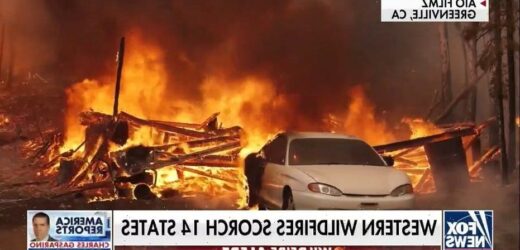Firefighters prepare for sweltering weekend as wildfires scorch California, Oregon
Senior correspondent Claudia Cowan reports on wildfires that have destroyed towns and span 14 western states.
Videos released online show the extent of the various wildfires ravaging California right now, and the effects can be seen from outer space.
The National Oceanic and Atmospheric Administration (NOAA) released a video on Twitter last week showing the West Coast of the United States. In the video, several plumes of smoke from the massive wildfires are clearly visible.
In a separate post, the NOAA noted that the red marks were an overlay of fire temperature visualization: Only the smoke can be seen from space, but the smoke has blanketed most of the United States in “a hazy pall.”
More footage from satellites released by a UCLA environmental professor shows the actively burning fires and billowing smoke in alarming clarity.
“NorCal fire situation escalated this PM to level many of us feared it would this season, given extreme drought & record-dry vegetation, with multiple towns impacted by fast-moving fire fronts in past several hours,” Daniel Swain, climate scientist with the UCLA Institute of the Environment and Sustainability, wrote on Twitter.
California’s largest wildfire continued to grow Wednesday as thousands of firefighters prepared for a tougher fight due to the return of dangerous weather.
A red flag warning was issued through Thursday because of hot, bone-dry conditions with winds up to 40 mph. That could drive flames through timber, brush and grass, especially along the northern and northeastern sides of the vast Dixie Fire.
“I think we definitely have a few hard days ahead of us,” said Shannon Prather with the U.S. Forest Service.
Heat from the flames created a pyrocumulus cloud, a massive column of smoke that rose 30,000 feet (10,000 yards) in the air, said Mike Wink, a state fire operations section chief.
More than 20,000 firefighters and support personnel were battling 97 large, active wildfires covering 2,919 square miles (7,560 square kilometers) in 13 U.S. states, the National Interagency Fire Center said.
The Associated Press contributed to this report.
Source: Read Full Article



